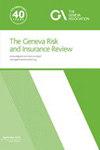数量约束下对收入风险的态度
IF 1
3区 经济学
Q4 BUSINESS, FINANCE
引用次数: 37
摘要
考虑到具有标准偏好的消费者,我追踪了市场上的数量限制如何影响相对风险厌恶和审慎。我首先展示了这种影响如何分解为局部曲率效应和内生变化的风险规避/审慎效应。接下来,我利用对家庭耐用品需求和劳动力供应的估计,校准了对相对风险厌恶和审慎的影响。校准表明,对耐用品的承诺对风险态度有很大影响。虽然实际劳动力供给水平与预期劳动力供给水平之间的微小差距只会产生温和的影响,但获得60%失业救济金的全职失业人员,会显著提高风险规避和审慎程度。本文章由计算机程序翻译,如有差异,请以英文原文为准。
Attitudes Towards Income Risk in the Presence of Quantity Constraints
Considering a consumer with standard preferences, I trace out how quantity constraints on markets impact on relative risk aversion and prudence. I first show how this impact decomposes into a local curvature effect and an endogenously changing risk aversion/prudence effect. Next, I calibrate both effects on relative risk aversion and prudence, using estimates on household demand for durables and labour supply. The calibrations show that commitments to durable goods have large effects on attitudes towards risk. And while small wedges between realised and desired levels of labour supply have only moderate effects, becoming full time unemployed on a 60 per cent unemployment benefit significantly raises risk aversion and prudence.
求助全文
通过发布文献求助,成功后即可免费获取论文全文。
去求助
来源期刊

Geneva Risk and Insurance Review
Multiple-
CiteScore
4.30
自引率
0.00%
发文量
8
期刊介绍:
The Geneva Risk and Insurance Review (GRIR), the academic journal of The Geneva Association, is the flagship journal of the European Group of Risk and Insurance Economists (EGRIE). The GRIR publishes original research that advances our understanding of the economics of risk and uncertainty and the management thereof through insurance and other mechanisms.
Specific focus areas include: the economics of insurance products and markets; decision theory under uncertainty; risk sharing or risk mitigation mechanisms for individuals, corporations, and society; market failures related to risk sharing and mitigation mechanisms, including those arising from information frictions and incentive problems; and the role of government in managing risk through regulation or social insurance provision.
The GRIR emphasizes scientifically rigorous research that is well-grounded in economic theory, based on both neoclassical and behavioral approaches. This includes pure theoretical research, empirical or experimental research that aims to test, falsify, or otherwise elucidate existing theoretical work as well as applied theoretical research that is of direct applicability to practitioners and policymakers.
The GRIR is well indexed, including EconLit, the Social Science Citation Index, and RePEC.
Until June 2005, the Journal was published as "The Geneva Papers on Risk and Insurance Theory".
 求助内容:
求助内容: 应助结果提醒方式:
应助结果提醒方式:


